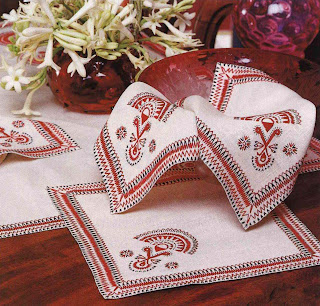Cross Stitch with free lessons and patterns. Find free counted cross stitch patterns.
Sunday, July 25, 2010
Polish Embroidery
Embroideries of Poland are as varied as the ethic make-up of its people. Ranging from brightly-coloured and Whitework floral designs, sashes, and white rabbit fur lined embroidered coats and hats to Goldworked religious robes, many examples can still be seen today either in Poland or in the adopted countries of Polish emigrants.
With a population of just under 40 million, Poland is bordered on the north by the Baltic Sea, and from the east to the south-west, by Germany, the Czech Republic, Slovakia, Ukraine, Belarus, Lithuania and Russia. The history of Poland has been likened to the story of the phoenix, the miraculous bird that dies in fire every thousand years only to rise once more. Since 1772, Poland has been partitioned and annexed by Russia, Austria and Prussia. However the establishment of the Kingdom of Poland in 1815, peasant revolts throughout the 1800s, WWI, the Russian Revolution, dictatorial reigns, WWII and finally the dissolution of the Soviet Union have all left their mark on this country.
The word 'Pole' means 'lowlander' or 'plain-dweller' and apart from the southern mountainous region, the remainder of the country is relatively flat by European standards. The Polish people are the western branch of the 'Slavic' people who were driven northward, firstly by the Romans and then the Avars (Hungary) until they settled in the land along the river Vistula. With the origins of the people in mind, Polish embroideries are similar to the colourful floral Ukrainian and eastern Slovakian embroideries worked on coats and men's woollen trousers. The Silesian
region of Poland is famous for its Goldwork and negative pattern cross-stitch designs similar to Assissi embroidery. The couched gold thread embroidery is worked over card templates based on designs from medieval Christian vestments and altar frontals.
There are several embroidery styles unique to Poland. One is Snutki, or spiderweb embroidery, featured in a previous issue of this magazine and made up of a pattern of buttonhole-edged eyelets linked with thread bars across cutwork areas. The other unique style is called Kurpie, named after the forested region to the north, halfway between the Russian border and the capital, Warsaw. Kurpie embroidery is surface stitchery in mainly red with black highlights and designs based on a series of circles, half circles and stylised plants in satin stitch, chain stitch, running stitch, overcast stitch, feather stitch and Kurpie stitch.
Kurpie stitch is worked similar to the pulled-fabric single faggot stitch, however instead of forming a pattern by pulling the stitches firmly, it is worked as a surface stitch. The front of the work has continuous V-shapes forming a zigzag with what looks like running stitches on the back. The unusual combination of red on the outer rows of Kurpie stitch 'A', with a row of black on the next row in a V-shape, looks like a two-toned chain stitch and is very effective.
The featured tablecloth and six napkins are worked on ecru linen and finished off with a 5mm (Vioin) hand-stitched hem. The first outer row in black is worked over this hem, then followed by one row of red, a row of closely-worked Kurpie stitch, separate black row and finally a continuous row of red Kurpie stitch (a total of five rows of Kurpie stitch). The corners of the cloth are embroidered with three circles outside the semicircular stylised plant design. The semicircle is worked in satin stitch, running stitch, Kurpie stitch and chain stitch with what looks like crossed hockey sticks being worked in chain stitch. The evenness of the circles is amazing, as it is extremely difficult to maintain the intregrity of the shape when working freehand. These triple-corner circles are similar to the designs worked on everyday shirts, whereas wedding shirts are only embroidered in white on white linen. The photographed ladies' blouse is worked with red and white No. 8 Perle Cotton in a floral design with gathered and smocked cuffs and shoulders with rolled-edged hems on the yoke, double collar and cuffs.
Today, Polish national costumes are worn for religious and social ceremonies not as everyday wear.
In the past, costumes were used to distinguish between regions, villages and occupation as well as signifying wealth. Several communities have retained their regional costumes, including the highlanders of Polhale, Kurpie and Lowicz near Warsaw. Silk sashes known as 'kontuszy' were an indispensable part of a Polish nobleman's costume. The sashes were several metres in length, wrapped around the waist and tied in a decorative knot so that the fringed ends hung downwards. These sashes were initially imported from Persia in the 17th century, however Armenian weavers established workshops in many areas of Poland to produce local versions of Persian designs. Double-sided weaving techniques meant the sashes could be folded in half to show two totally different designs or colour schemes. While these sashes were reserved for nobility, sashes are still worn as part of the costumes of Cracow. The knotted sashes are beautifully embroidered and edged with tassels along the lower edge. Waistcoats and hats known as square-buttoned 'rogatiwka' were embroidered, whereas in Cracow, the trousers are left plain.
In Cracow, ladies' costumes have beautifully-embroidered hats, skirts, and waistcoats worked predominantly in red, with black highlights. Their white aprons, a feature of the costume, are embroidered with white geometric patterns. Cracow is also renowned for its Whitework consisting of cut-eyelet embroidery in floral trailings similar to broderie anglaise.
A book titled Old World Stitchery for Today, written in English by Grazyna J. Kozaczka, is one of the few recently published books available on Polish embroidery. This book has working instructions, a good bibliography useful for further research, along with traditional designs adapted from costumes and antique linens, the origins of the styles and the development of embroideries throughout the centuries.
Subscribe to:
Post Comments (Atom)



Bravo...
ReplyDelete